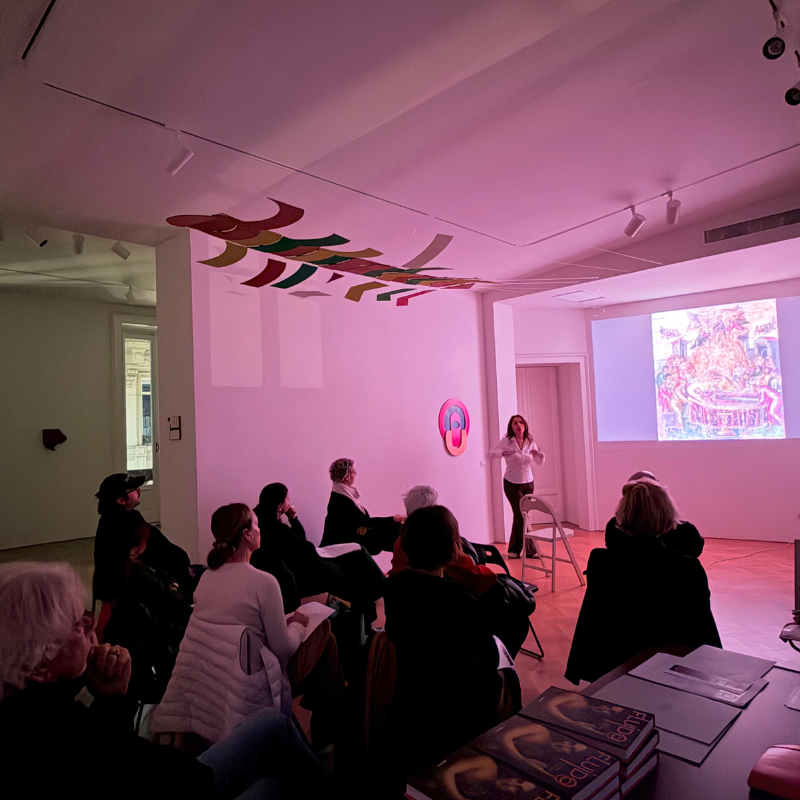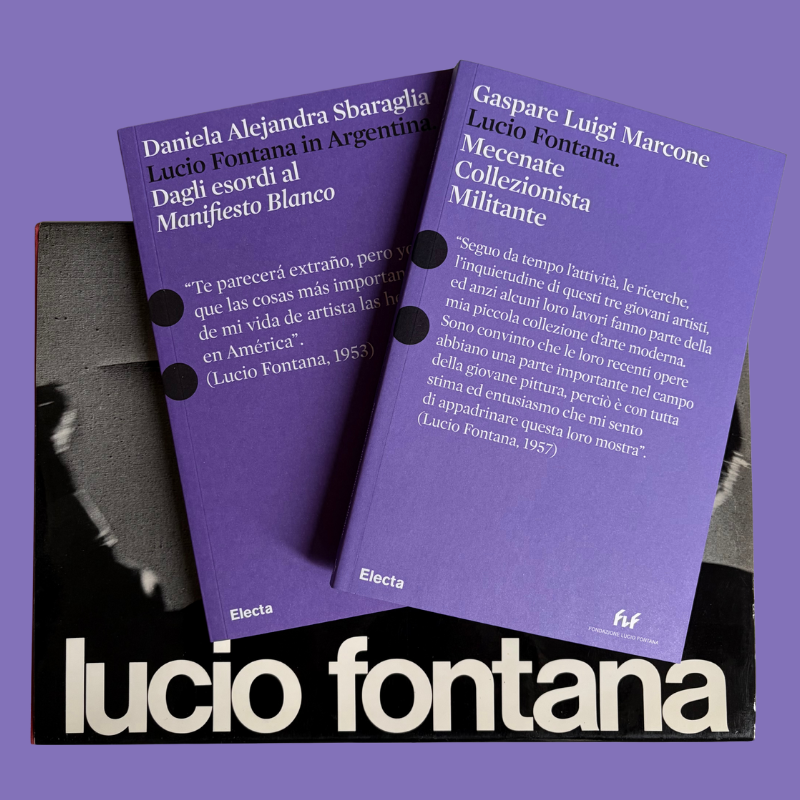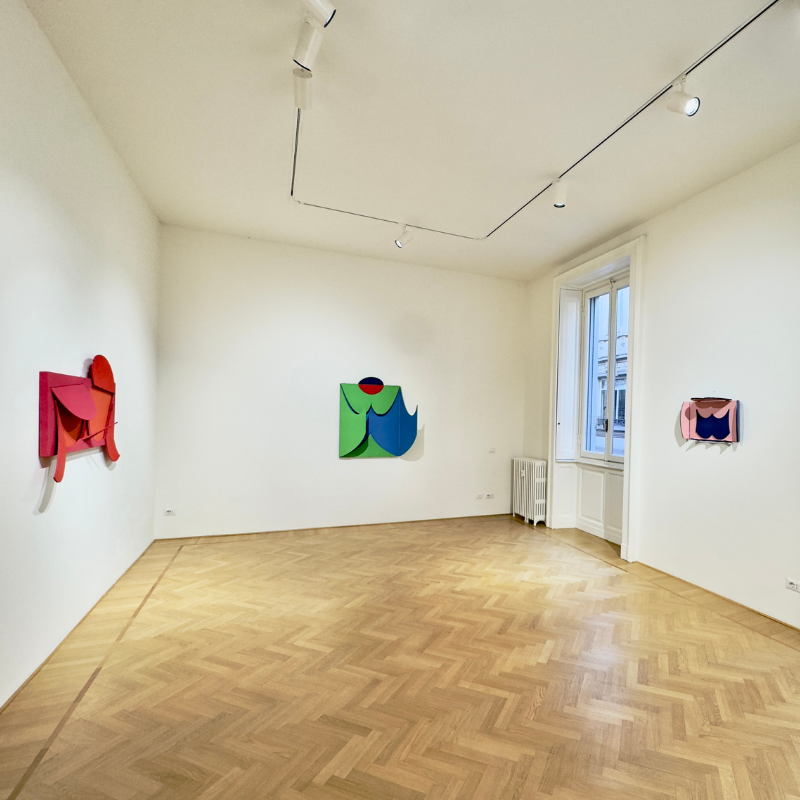NEWS
Full of Art
FLUIDO
24.11.2025
FLUIDO is a book by journalist and essayist Roberta Scorranese. Fluido is also a performative reading that Scorranese presented at Studio Gariboldi—an expressive way of recounting the volume through the very images that accompany it. Three aspects, in particular, invited deeper reflection: first, the paintings and sculptures that explore representations of fatherhood; second, the awareness that art history contains a remarkable number of portrayals of sleeping women; and third—an element on which Scorranese placed special emphasis—the essential need to encounter artworks directly, without the mediation of social media, by visiting museums, collections, and art galleries.
Upon entering our space, the author expressed it this way: “How wonderful it is to be in a gallery talking about art and about my book!”
FLUIDO is thus a twofold invitation: on the one hand, to let oneself be carried by the shifting, metamorphic nature of bodies in art; and on the other, whenever and wherever possible, to seek out the places that safeguard their aesthetic and artistic legacy.
Bookflow
Lucio Fontana
20.11.2025
On Wednesday, November 19, in Lucio Fontana’s former studio on Corso Monforte 23, the publication of two volumes dedicated to the artist was announced to the public.
The first, Lucio Fontana. Mecenate Collezionista Militante, edited by Gaspare Luigi Marcone, focuses on Fontana’s aesthetic and conceptual choices, delving into his role as a patron—both financially and critically—in support of artists who were pivotal to twentieth-century art.
The second, Lucio Fontana in Argentina. From His Beginnings to the Manifiesto Blanco, edited by Daniela Alejandra Sbaraglia, explores Lucio Fontana’s years in Argentina, his birthplace. This period has recently been the subject of renewed scholarly attention thanks to recent studies and discoveries that have broadened its understanding and led to a reconsideration of its significance. We are certain that both books will also be of interest to our collectors and audience.
Lucio Fontana. Mecenate Collezionista Militante, Gaspare Luigi Marcone, Electa, Fondazione Lucio Fontana, 2025
Lucio Fontana in Argentina. From His Beginnings to the Manifiesto Blanco, Daniela Alejandra Sbaraglia, Electa, Fondazione Lucio Fontana, 2025
Bookflow
Parigi
06.11.2025
“At the Louvre. Lorrain with his peach-colored skies, his radiant light. Among all painters, no one has so wonderfully suggested what the lost country might be — that land of Elsewhere destined to haunt humanity forever.”
A walk through Paris — along its boulevards, stepping in and out of palaces and museums, climbing and descending staircases both famous and hidden.
This book is for those who love this city, and for those who don’t fully understand it.
Paris, as described by Julien Green — an American writer who spent most of his life in France — is an emotional and imagined place: a point of departure and beginning of stories, a blend of melancholy, sadness, and joy.
Paris is fragile and threatened, resistant to haste, cautious in revealing itself; it offers itself only to those capable of getting lost and seeing it with wonder and detachment.
Far from commerce and tourism, this is the Paris we love — an inner, secret world with a famous name.
Julien Green, Paris, translated by Marina Karan, Adelphi, 2023.
Bookflow
Digital catalog Katsumi Nakai
03.11.2025
The digital catalogue of the exhibition Katsumi Nakai. Flying High is now available.
It includes all the images of the works on display, a historical essay by Stefano Turina — who also authored the texts dedicated to Aiko Miyawaki — as well as Nakai’s biography and the complete list of his solo exhibitions in Italy and abroad.
Throughout the month of November, the catalogue will be available for free download.
Request your copy by clicking the link below:
press@studiogariboldi.com
Vernissage
Gallerie a Palazzo
29.10.2025
Every year in November, the courtyard at Corso Monforte 23 opens to the city of Milan in the evening for Gallerie a Palazzo, now in its fifth edition.
On Tuesday, November 11, from 6:00 PM, visitors will be able to move between the seven galleries based in the courtyard, each of which will present a different exhibition for the occasion.
Studio Gariboldi invites you to the 5:00 PM talk in the gallery. On this occasion, art historian Stefano Turina and Natsuko Toyofuku, daughter of the sculptor Tomonori Toyofuku, will discuss the relationships between Japanese and Italian artists active in Milan during the 1960s and 1970s.
Free admission, reservation required at press@studiogariboldi.com or +39 02 21711378.
Mostre
Katsumi Nakai. A Dialogue Between Japan and Italy
28.10.2025
On October 16, we opened the exhibition Katsumi Nakai. Flying High — the second solo show dedicated to the Japanese artist, featuring works from the 1960s and 1970s. The exhibition is part of a broader artistic and cultural project that has defined the gallery since its foundation.
Studio Gariboldi’s research began with postwar Italian and international informal painting and continues to explore the connections between artists who lived and worked in Milan during the 1950s, 1960s, and 1970s.
In recent years, the focus has turned to the relationship between Italy and Japan: artists such as Katsumi Nakai, Yayoi Kusama, Tomonori Toyofuku, Aiko Miyawaki, Nobuya Abe, Key Hiraga, and others have been presented in our gallery, narrating the artistic story of that era — one deeply rooted in the courtyard of Corso Monforte 23, where Lucio Fontana had his studio and lasting friendships were born.
Flying High also includes a photographic section displaying images of iconic Milanese interiors and exhibition views personally curated by Nakai in the 1970s.
The exhibition is open Monday to Friday, until January 30.
from 11 a.m. to 1 p.m., and 2 p.m. to 6 p.m.
Exhibitions
Katsumi Nakai. Flying high
21.10.2025
Katsumi Nakai. Flying High
16 October 2025 – 30 January 2026
After his early abstract-informal explorations with the Tekkeikai group in Osaka, Katsumi Nakai found in Milan, from 1964 onward, a stimulating environment that led to a transformation of his artistic production. While his debut in Venice was still painterly, at his 1967 solo exhibition at the Galleria del Naviglio in Milan he presented his new “painting-objects”: shaped and painted wooden works that unfold to take on ever-changing forms.
These are works that invite reflection on the poetry of blossoming — of opening (hiraku) — and of constant transformation. Through a coherent and evolving research, enriched by multiple influences, Nakai created works that make the imagination “fly high,” recalling the lightness and endless variety of Japanese kites (tako). These notes focus on those very aspects of Nakai’s practice, documented also by contemporary reflections.
Corso Monforte 23, Milan, 20122
Exhibitions
Robert Doisneau
07.10.2025
“The exhibition Robert Doisneau. Instants marks the return of Robert Doisneau’s photographs to Paris after years of absence.
Some 350 photographs have been carefully selected from the 450,000 in the collection. The iconic images stand side by side with completely renewed series, demonstrating the photographer’s dexterity in exploring human beings in a wide range of environments: childhood, artists, writers, bistros, the Vogue years, but also the harshness and gravity of life (…)”










